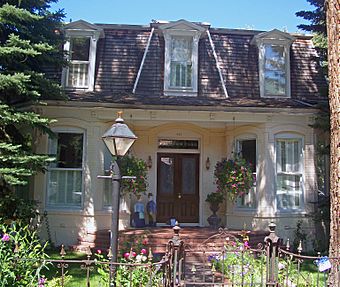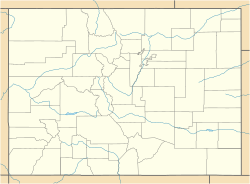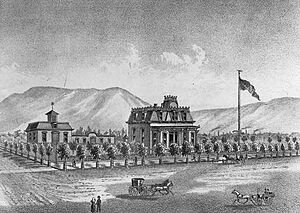Pioneer Park (Aspen, Colorado) facts for kids
Quick facts for kids |
|
|
Henry Webber House
|
|

South elevation, 2010
|
|
| Location | Aspen, CO |
|---|---|
| Built | 1885 |
| Architectural style | Second Empire |
| MPS | Historic Resources of Aspen MRA |
| NRHP reference No. | 87000189 |
| Added to NRHP | March 6, 1987 |
Pioneer Park, also known as the Henry Webber House, is a historic home in Aspen, Colorado, United States. It was built in the 1880s using brick, which was unusual for homes in Aspen at that time. In 1987, it was added to the National Register of Historic Places, recognizing its special history.
The house was built by Henry Webber, a successful shoe merchant. He became very rich from his investments in silver mines during Aspen's early boom. Some people say the house is haunted by the ghost of his wife, Harriet, who passed away there. This house is the only one in Aspen that still shows the original Second Empire style, especially inside.
Later, the house was owned by Walter Paepcke, a businessman from Chicago. He helped turn Aspen into a famous ski resort town in the mid-1900s. While Paepcke lived there, he invited the famous humanitarian Albert Schweitzer to visit Aspen. Schweitzer gave a big speech at a festival Paepcke organized. This was Schweitzer's only visit to the U.S. He stayed in the small building behind the main house, called the carriage house. Today, this building is known as Schweitzer Cottage. The Henry Webber House is still a private home today.
Contents
Exploring the House and Grounds
The Henry Webber House is located in Aspen's quiet West End. It sits on the north side of West Bleeker Street. Aspen Mountain rises steeply just two blocks south of the house.
The property is quite large, taking up half of the city block. The eastern part of the land is a beautiful landscaped area. It has tall cottonwood trees and winding paths. The house itself is on the western side of the property.
Outside the House
The house is a one-and-a-half-story building made of brick. It has a special mansard roof covered in shingles. At the back, there is a smaller addition. A long section extends from the back, placing the house near its swimming pool. In front, there is an old iron fence and a line of tall trees.
The front of the house has two rounded bay windows. These windows have double-hung sashes, meaning they open from both the top and bottom. The main entrance is in the middle, with double wooden doors. You reach the doors by walking up a few wide brick steps. The words "Pioneer Park" are written on the glass above the doors.
Above the windows, the roof gently curves out, creating overhanging eaves. Three dormer windows stick out from the steep part of the roof. The middle dormer is set in a slightly projecting shape. On the sides of the house, there are three narrow windows and a wider one in the center. At the back, there is a two-story kitchen area.
Inside the House
When you step inside, you'll see lots of original black walnut wood. This beautiful wood is used for the doors, window frames, and even the stairway. It's unusual to see so much of it, especially upstairs.
All the rooms on the first floor have very high ceilings. The doors almost reach the top! In the living room, the ceiling has wide molding and a plaster design in the center. A chandelier hangs from this design. There's also a carved marble fireplace in the living room. Another room, perhaps a library, has a fireplace with a painted wooden frame.
Other Buildings
The property also has a few other buildings. There's a garage next to the house. In the northeast corner, you'll find a wooden octagonal summer house. The most important outbuilding is the carriage house. It looks similar to the main house and is considered a historic part of the property. It's located on the west side, facing North Fourth Street.
A Look Back in Time
Henry Webber and his wife Harriet came to Aspen in 1880. At that time, Aspen was just a small mining camp. Harriet was one of only 13 women who spent that winter there. The town was starting to grow quickly because of all the silver being found in the mountains. The Webbers started a business selling and fixing shoes and clothes. They also began investing in the local mines.
Both their businesses did very well, making them wealthy. Sadly, Harriet Webber died in 1881. Henry Webber became the city treasurer in 1883. Two years later, he built this house. People say Harriet's ghost still haunts the house he built. Many successful people in Aspen were building homes in different Victorian styles. Webber chose the Second Empire style for his house, which was not very common. It's the only house in Aspen today that still has its original Second Empire look, including the iron fence outside.
Henry Webber later served a term as mayor of Aspen. After this, Aspen's economy began to slow down. The years after 1893, when the price of silver dropped, are known as "the quiet years." Aspen's population fell from over 10,000 to just 500 by 1930. Many buildings were left empty and were destroyed by fires or harsh winters. The Pioneer Park house survived because after Webber's death in 1911, it became the home of the Prechtls, who were local blacksmiths.
In 1944, Walter Paepcke bought the house. He was a businessman from Chicago. Walter and his wife Elizabeth saw that Aspen could become a great ski resort. They helped fund the first developments of the Aspen Mountain ski area. The Paepckes also worked to make Aspen a cultural hub. They are seen as the founders of modern Aspen.
In 1949, Walter Paepcke organized a festival in Aspen. It celebrated the 200th birthday of the German poet Johann Wolfgang von Goethe. Paepcke invited the famous German humanitarian Albert Schweitzer to give the main speech. Schweitzer came from his work in West Africa. This was his only visit to the United States. While in Aspen, Schweitzer stayed in the carriage house on the Pioneer Park property. Today, that building is called Schweitzer Cottage in his honor.
While Paepcke owned the house, he painted it pink. Since then, it has been painted a light tan color. Walter and Elizabeth also built the summer house and the garage. They might have added the marble fireplace in the living room too. After 1980, more parts were added to the house, and the swimming pool was built. The trees around the house have also grown tall, giving it more shade and privacy.
See also
 In Spanish: Pioneer Park (Aspen) para niños
In Spanish: Pioneer Park (Aspen) para niños



